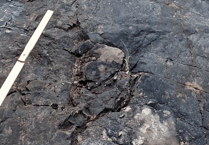This letter sent to this week's West Somerset Free Press explains the full reasons behind the instability of the cliffs at Cleeve Hill near Watchet, which has led to the indefinite closure of the B3191. Have you been affected? And what should happen now? Have your say in the comments, or email news@wsfp.co.uk
Geckoella was pleased to have been invited by Somerset Council to the recent ‘Open evening event’ held at the Phoenix Centre, Watchet on Thursday 23rd March. This provided a welcome opportunity in our role as geotechnical specialists to present and share our latest drone footage and photographs of West Cliff, the allotments and Cleeve Hill.
We also explained to everyone who spoke with us that the primary reasons for the cliff failure along this stretch of coast relate mainly to a combination of geological and environmental factors.
These include the naturally soft geology of the red Triassic mudstone and grey lower Jurassic shale and limestone cliffs; their complex deformation and weakness due to the proximity of the Watchet Fault; erosion at the base of the cliffs by the sea (rates of which are increasing due to rising sea levels); and the impacts of hydrological and drainage issues at the cliff top and within the cliffs (exacerbated by heavy, more frequent and prolonged periods of rainfall).
Some of these factors are unquestionably related to climate change, and one of the challenges now facing Watchet and other coastal communities located on these types of soft cliffs, is how best to adapt to the changing environmental conditions.
Dr Andy King
Director & Principal Geologist
Geckoella Ltd




